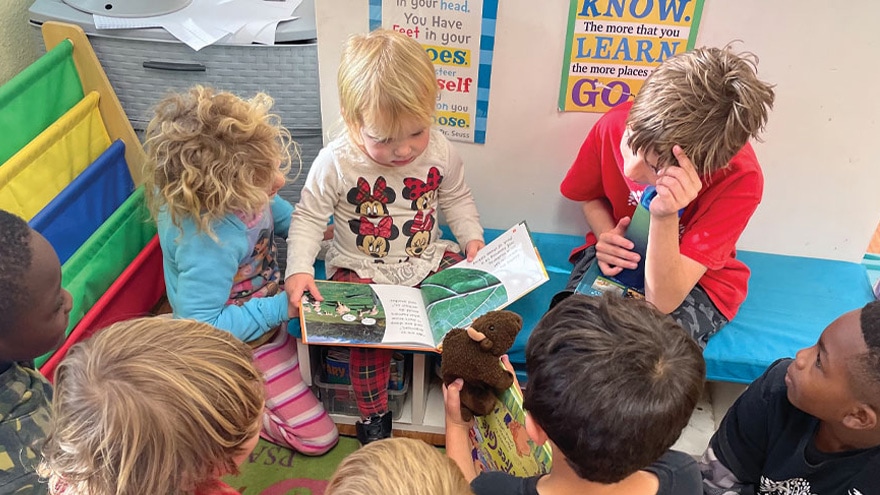
The best part of being an early childhood educator is watching children develop personal relationships with Jesus.
So many students have come into our prekindergarten and kindergarten classrooms asking what prayer is, who Jesus is, or what a Bible is. What a privilege it is to respond to these questions!
The answers are not simple definitions, discussions, or even whole units of study; instead, they are found in a personal relationship that develops only through the work of the Holy Spirit with each child.
As an early childhood educator, I provide a safe, engaging environment that supports students’ spiritual development. Of course, what that looks like varies from day to day and classroom to classroom, but here are some of my favored activities that help students’ spiritual development.
Prayer First and Last
First, we always begin and end our day with prayer. Students get excited about the concept that the Creator of the universe cares to listen to anything we want to bring to Him. During prayer request time, students share their concerns and praises with the class, and we bring them to God together. Students eagerly take turns being the prayer leader.
We talk about how God always listens to our prayers. He loves us and always answers in the best way. Just like parents and caregivers, God doesn’t always give us what we ask for, but we can trust that He always does what is best for us. Students get into the habit of praying for each other and themselves and thanking God for blessings they notice throughout the day.
At the beginning of the year, we set up a prayer station where students can have quiet time with God and pray about anything they want. Students enjoy a variety of activities at the prayer station, like making prayer chains, listening to music while they pray, or making books about prayers God has answered.
The True Word of God
Throughout the year, we discuss how the Bible is not just another ordinary book of fiction. It is the true Word of God. It contains all of the important information Jesus wants us to know here on earth so we can spend eternity with Him.
Students learn to treat the Bible with reverence. They understand that we can trust the Bible because we can always trust its Author, God. We learn about Christ’s nature through the stories and discuss how He wants us to treat each other.
The Truth in the Story
Each week, we study a new Bible story. We learn about the story’s context, discuss the characters’ feelings and choices, look for the lessons God has for us in each story, and participate in activities that help students better understand the concepts.
One of lessons I like best is the story in Mark 2:1-12 of the four men who lowered their paralyzed friend through the roof so Jesus could heal him. For this lesson, we use cardboard, mud, leaves, and pine straw to make a house with a flat roof. This helps students better understand what houses looked like in biblical times, and how the four men made a hole in the ceiling. When we study Jonah, students participate in an object-lesson activity where they try to run away from their shadow. Just like their shadow, God is always with them.
Bible stories are usually a springboard for deep, student-led conversations and lessons. For example, after we study Mark 2:1-12, students almost always ask about the hole left in the roof. Did the homeowners forgive the four men? Did the man who was healed help fix the roof? Students share what they would have done. I ask what they think Jesus would have done.
Similarly, students ponder what Jonah would have felt like and smelled like after spending three days in the belly of the fish. What would have happened to Jonah in the storm if the fish had not swallowed him? Would the story have ended differently if Jonah had obeyed God the first time He told him to go to Nineveh? What can we learn from this?
Share It at Home
Students take home a simplified version of the Bible story or a Bible craft each Friday to tell their families the story in their own words. We practice the story in class, and students leave eager to share the Word of God with their family and friends. When they come back to school on Monday, I invite students to share their experiences. Students gain a sense of accomplishment and find joy in spreading the gospel message.
While my work focuses on bringing children to develop a personal relationship with Christ, children have much to teach us in this area. Matthew 18:2-4 says, “He called a little child to him, and placed the child among them. And he said: ‘Truly I tell you, unless you change and become like little children, you will never enter the kingdom of heaven. Therefore, whoever takes the lowly position of this child is the greatest in the kingdom of heaven’ ” (NIV).
From birth, children have an innate expectation for caregivers to meet their needs. They begin life with faith and the ability to completely trust in their caregivers and what we present to them as true. Experience in this sin-laden world teaches us to doubt. Therefore, teaching children that they can trust in Jesus in these precious early years is extremely important.
The original version of this story was posted by Southern Tidings.